Europe
![]()
The title of this article is ambiguous. For other meanings, see Europe (disambiguation).
Europe
.svg.png)
![]()
Europe (ancient Greek Εὐρώπη Eurṓpē) is a continent that spans the western fifth of the Eurasian landmass. Although geographically it is only a subcontinent that, together with Asia, forms the continent of Eurasia, historically and culturally it is often considered a continent in its own right. The term "Europe" is therefore not defined purely geographically, but also refers to historical, cultural, political, economic, legal, idealistic aspects.
The inhabitants of Europe are called Europeans. With over 700 million inhabitants living in an area of about 10.5 million square kilometres, Europe is one of the more densely populated parts of the world. Europe is highly urbanized, especially around its capital cities and the "Blue Banana" megalopolis. Major political alliances of Europe are mainly the Council of Europe and the European Union.
Name
The name "Europa" derives from the ancient Greek Εὐρώπη (Eurṓpē). Within Greek, the name could be understood as a compound of εὐρύς, eurýs, "wide, broad" and ὄψ, óps, "sight, face", giving the meanings "the one with the wide sight" or "the broad-faced one".
According to Greek mythology, Eurṓpē was the name of a Phoenician king's daughter whom Zeus, swimming in the form of a bull, carried off to Crete and seduced there. This name is believed by etymologists to have originated in a Semitic language and then been Graecized. An origin from the Akkadian erebu "to set" (referring to the sun) or also from the Phoenician erob "evening, west" (cf. the term "Occident") is discussed.
In the 5th century B.C. the Greek writer and geographer Herodotus applied the term Eurṓpē, which as a geographical term at that time had referred only to the Peloponnese, to the land masses north of the Mediterranean and the Black Sea, which he thus distinguished from the land masses of Asia (Asía) and Africa (Libýe).
Europe itself is the namesake of the chemical element Europium, which was discovered in 1890.

Europe, the bull and companions , fresco from Pompeii
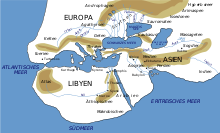
Europe in Herodotus' ancient world view
Geography
→ Main article: Geography of Europe
Europe has no clear geographical or geological border to the east of Asia. Therefore, the 'borders of Europe' are a matter of social agreement. A geographical definition of Europe is always arbitrary. According to a well-known formulation by Bernard-Henri Lévy, Europe is 'not a place but an idea'. Today, the demarcation between Europe and Asia usually follows Philip Johan von Strahlenberg's definition to a large extent. According to this definition, the Ural Mountains and River form the eastern border of Europe. Between the Caspian Sea and the Black Sea, the boundary line runs through the Manytschniederung north of the Caucasus Mountains, as a sea lane once connected the Caspian Sea with the Black Sea at its location. The globe shown above draws the border - deviating slightly from it - along the main ridge of the Caucasus; this border demarcation is preferred in English- and French-speaking countries (→ Inner Eurasian border).
In total, Europe has an area of about 10.5 million square kilometres, making it the second smallest continent after Australia. The northernmost point of the European mainland is Kinnarodden on the North Finn Peninsula in Norway, the southernmost is Punta de Tarifa in Spain, the westernmost is Cabo da Roca in Portugal. The north-south extension is about 3800 km. In east-west direction the European mainland measures about 6000 km, from the Ural Mountains in Russia to the Atlantic coast of Portugal.
Climate
The continent lies mainly in temperate latitudes. The climate in Europe is milder compared to areas of the same latitude in other parts of the world due to the influence of the relatively warm Gulf Stream. The average annual temperature of Bordeaux, for example, is 12.8 °C, while Halifax (Nova Scotia), Canada, located at almost the same latitude, reaches only 6.3 °C.
In large parts of Western Europe, mild winters are contrasted by cool summers. In areas that are far away from the sea, i.e. also from its climatically balancing influence, the temperature differences in different seasons are stronger. In most parts of Eastern Europe, the climate is predominantly continental due to the absence of the sea in the immediate vicinity. Cold winters and hot summers are predominant in these regions.
Due to the earth's rotation and the associated deflecting force, winds come mainly from a westerly direction. Since in the coastal areas of Western Europe, therefore, winds blow mainly from the Atlantic Ocean, rain falls almost all year round. In Eastern and Central Europe, on the other hand, the amount of precipitation is comparatively low, because again the influence of the sea on these regions is too small. Mountains also have a strong influence on the amount of precipitation. Parts of the northwestern Alps, for example, are among the areas with the highest precipitation in Europe, while central Alpine valleys are comparatively dry. In this case, the Alps act as a barrier to rain fronts.
In areas near the Mediterranean, the climate is predominantly Mediterranean with subtropical winter rains. The dry and very warm summers are followed by mild and partly rainy winters. The average air temperature in summer is between 22 °C in the western and 27 °C in the eastern Mediterranean. In the winter between 8 °C in the Aegean, while the northern Mediterranean near Venice has January temperatures of only 3 °C. In summer there are predominantly winds from the north, the Etesias. In winter, on the other hand, westerly winds from the direction of the Atlantic Ocean often bring precipitation. Due to the relatively high water temperatures in autumn and winter, the precipitation totals reach the highest values in Europe, especially in stagnant locations (uphill rains) of the eastern Adriatic frame. In Montenegro, the maximum precipitation is more than 4500 mm/a (Crkvice), which is almost twice as high as in the dam locations of the Northern Alps. Especially in winter, cold wind currents cause an exchange of air masses between polar cold air and subtropical air masses. These winds blow especially at natural relief outflows such as the Mistral in the Rhone Valley and the Bora over the low lying passes in the Kvarner Gulf and off Istria.
Northern Europe has an arctic climate, while the southeastern Volga region has a continental climate with hot summers and low precipitation. For example, Lapland may still be covered in snow, while Sicily complains of summer heat, the Shetland Islands are constantly raining, and Andalusia is plagued by years of drought.
See also: Consequences of global warming in Europe and List of weather events in Europe
Flora
The vegetation in Europe can be roughly divided into four zones based on the climate: arctic, boreal, temperate and Mediterranean. Due to thousands of years of use, the original vegetation of Europe in the temperate and Mediterranean zones has been destroyed except for tiny remnants. In northern Europe, only shrubs, mosses and lichens are found in the arctic tundra. Further south, Scandinavia and northern Russia are joined by boreal coniferous forests (mainly of spruce and pine) in which extensive bogs are embedded. In the temperate zone, between the Atlantic Ocean and the Carpathians, deciduous forests dominated by copper beech would probably grow under natural conditions, with deciduous oak and hornbeam in the warmest lowlands. East of the distribution area of the copper beech, approximately from the Vistula and the Dniester to the southern Ural, mixed forests would be formed, in which English oak, small-leaved lime, Scots pine and - in the transition to the coniferous forest zone to the north - spruce play the most important role. To the south, this mixed forest zone is joined north of the Black Sea by a region in which steppe vegetation would have developed under natural conditions.
The Mediterranean region was probably also originally largely forested. Without human influence, the vegetation there would have been characterised by Mediterranean hardwood forest, which would have been dominated by evergreen oak species (especially holm oak), in the southernmost and warmest locations also with strong participation of olive trees, pistachios and pines. Due to the anthropogenic influence, however, nowadays mainly macchia or garigue plants grow. In the cooler areas of the Mediterranean region, various deciduous oak species, such as the downy oak, also play an important role. In the middle and higher altitudes of the mountains, the original vegetation is better preserved than in the lower altitudes. Here, in a relatively small area, several overlapping altitudinal zones are formed, whereby, depending on the climate, the individual components of such an altitudinal zoning can be very different. In the mountain forests of the middle-upper altitudes, fir and pine species are important in addition to the copper beech, while spruce and larch are also important in the more northerly mountains. Above the timberline, dwarf shrub heaths, alpine grasslands, and, in the Mediterranean region, thorn cushion vegetation are found in the mountains. Towards the top, the closed vegetation is replaced by individually growing rock and scree plants.
According to the controversial megaherbivore hypothesis, however, Europe would have been less forested before the influence of humans, but rather would have been dominated by varied grassland landscapes of meadows, scrub and smaller hute forests, formed by herbivores such as aurochs, bison, tarpan and red deer. This hypothesis is supported, among other things, by the abundance of oak and hazel pollen and the occurrence of other open-land species in Central Europe during the early Holocene.
Today, most of Europe is characterised by agricultural use, and the remaining forests are intensively used for forestry. Areas that have been less affected by humans are mainly found in the higher altitudes of the mountains.
Fauna
Large predators such as brown bear, Eurasian wolf or lynx are only found in larger populations in the north or east. In the extreme north and east of Europe, reindeer and elk are still relatively common. After its extinction, the bison was reintroduced from zoo stocks into Eastern Europe. Red deer, roe deer and wild boar are found in most regions of Europe. A typically European large animal species is the chamois, which is only found outside the European mountains in Asia Minor and the Asian parts of the Caucasus. Various species of ibex live in the Alps, Pyrenees and Caucasus. The saiga antelope was widespread as far as Ukraine as late as the Middle Ages, but today it is restricted in Europe to areas along the lower reaches of the Volga River. Many species have been exterminated centuries ago (Ur, Tarpan). The population of birds of prey, such as golden eagles, white-tailed eagles and griffon vultures, has also been severely decimated in recent centuries. Only in Southern Europe there is a larger number of species of lizards, snakes and turtles due to the warm climate. Seals and other seal species live along the coast. In the northern seas the best known cetaceans are the killer whale and the harbour porpoise, and in the Mediterranean various species of dolphins. The best known saltwater fish are herring and various species of tuna.
See also: List of mammals of Europe and List of European reptiles
See also: List of European amphibians and List of European freshwater fishes and lampreys
Cities and metropolises
Cities and municipalities are the smallest administrative units in the administrative structure of states. Lisbon was one of the first cosmopolitan metropolises of modern times, as it was the centre of a large colonial empire in the age of imperialism. As recently as 1950, four cities in what is now the European Union were among the 20 largest in the world; since then, European cities have hardly grown at all, in some cases losing population. These four largest EU cities today were London in second place behind New York, Paris in fourth place behind Tokyo, and Milan and Naples, which ranked 13th and 19th respectively.
But in the second half of the 20th century, cities in the rest of the world, especially those in developing countries, e.g. Mexico City, Manila or São Paulo, caught up in terms of population and now top the world's table. Despite stagnation in older cities, there are numerous other processes in spatial development in the 21st century, such as the gentrification of inner cities.
A problem with the comparison of metropolitan areas is that there are also often polycentric conurbations in which the core cities are very small compared to the conurbation (e.g. Rhine-Ruhr, the Upper Silesian industrial area or central England). Therefore, even though some of them are very large, they do not appear in the table below.
Cities with more than 1.5 million inhabitants in Europe are:
| # | City | State | Population in millions | Year of foundation | |
| with agglomeration | |||||
| 01 | Moscow | Russia | 010,4 | 013,8 | 1147 |
| 02 | London | United Kingdom | 007,4 | 012,0 | 0047 A.D. |
| 03 | Istanbul (West)* | Turkey | 006,9** | 016,0 | 0660 BC *** |
| 04 | Saint Petersburg | Russia | 004,8 | 005,3 | 1703 |
| 05 | Berlin | Germany | 003,5 | 004,5 | 1237 |
| 06 | Madrid | Spain | 003,3 | 005,3 | 1083 |
| 07 | Kiev | Ukraine Ukraine | 002,8 | 003,3 | 0840 |
| 08 | Rome | Italy | 002,7 | 003,8 | 0753 BC |
| 09 | Paris | France | 002,1 | 011,5 | 0053 BC |
| 10 | Minsk | Belarus | 001,7 | 002,7 | 1067 |
| 11 | Bucharest | Romania | 001,9 | 002,6 | 1459 |
| 12 | Vienna | Austria | 001,9 | 002,8 | 0881; 1st century AD. |
| 13 | Hamburg | Germany | 001,7 | 002,6 | early 9th century |
| 14 | Budapest | Hungary | 001,7 | 002,4 | 0089 A.D. |
| 15 | Warsaw | Poland | 001,7 | 002,4 | 1281 |
| 16 | Barcelona | Spain | 001,6 | 003,9 | 0230 B.C. |
| 17 | Munich | Germany | 001,5 | 002,4 | 1158 |
Istanbul is located on the border between Europe and Asia, the old city centre and about 2/3 of the city area belong to the European part.
** Number of inhabitants of the European part of Istanbul
*** as Byzantion on the European side
See also: List of capitals of the world and List of the largest cities in Europe
Time zones
The United Kingdom, Ireland, Portugal and Iceland have adopted Western European Time (GMT/WET), which is identical to Coordinated Universal Time (UTC). It corresponds to mean solar time at the prime meridian passing through London and eastern England.
All Central and some Western and Eastern European countries use Central European Time (UTC + one hour), these are Spain, France, Andorra, Monaco, the Netherlands, Belgium, Luxembourg, Denmark, Sweden, Norway, Germany, Poland, Austria, Switzerland, Liechtenstein, Italy, San Marino, the Vatican City, the Czech Republic, Slovakia, Hungary, Slovenia, Croatia, Bosnia and Herzegovina, Serbia, Montenegro, Northern Macedonia, Kosovo, Malta and Albania.
Eastern European time (UTC + 2 hours) is used by Finland, Estonia, Latvia, Lithuania, Ukraine, Romania, Moldova, Bulgaria and Greece.
Moscow time (UST + 3 hrs) is used by Belarus and most of the European part of Russia as well as Turkey.
Most countries use daylight saving time from the end of March to the end of October, with clocks being set forward by one hour over this period. This applies to all EU states, and most non-EU European states also follow this example, but not Iceland, Russia, Belarus and Turkey.
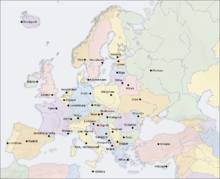
Political map of Europe with capitals
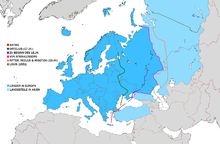
Different historical demarcations for the Europe-Asia border

Surface temperature of the Gulf Stream in the western North Atlantic; Florida and Cuba at lower left.
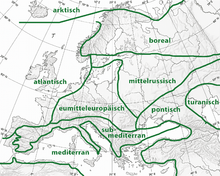
Floral regions in Europe according to Wolfgang Frey and Rainer Lösch

Biogeographical regions of Europe

Wolf (Canis lupus)
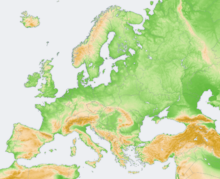
topography of Europe
Questions and Answers
Q: What is Europe?
A: Europe is the western part of the continent of Eurasia, often thought of as its own continent. It is separated from Asia by the Ural Mountains in Russia and the Bosporus strait in Turkey.
Q: How many countries are there in Europe?
A: There are at least 43 countries in Europe (the European identities of 5 transcontinental countries: Cyprus, Georgia, Kazakhstan, Russia and Turkey are disputed). Most of these countries are members of the European Union.
Q: How large is Europe?
A: Europe covers about 10,180,000 square kilometers (3,930,000 square miles). This is 2% of the Earth's surface (6.8% of its land area).
Q: How many people live in Europe?
A: As of 2017, about 510 million people lived in Europe.
Q: What is the most active volcano located in Europe?
A: The world's second most-active volcano located in Europe is Mount Etna which currently holds that title for being the most-active volcano on the continent.
Q: Why do people visit Europe?
A: People come from all over the world to see its many World Heritage Sites and other attractions.
Search within the encyclopedia